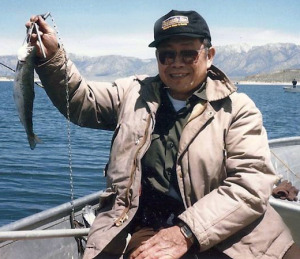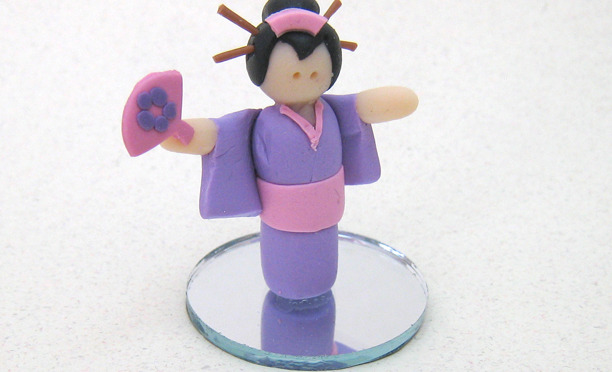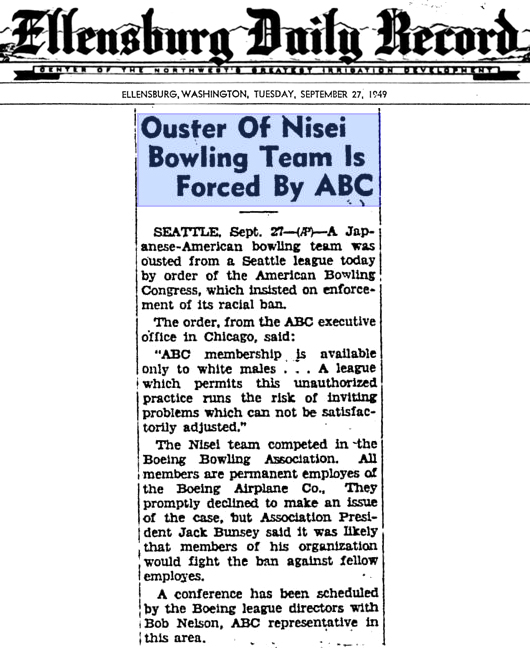All posts by admin
2014 HOLIDAY RESULTS
AMF BEVERLY LANES
December 7, 2014
No-Tap and Scotch Doubles
BOWLING AT A SKATE PARK?
COMMENDING JANBA
(Extensions of Remarks)
- Mr. Speaker, I rise today to recognize the Japanese American National Bowling Association (JANBA). From its noble inception to oppose discrimination after World War II, JANBA continues to be a forum for social interaction and friendly competition for its thousands of members throughout the United States.
- After internment in World War II, Japanese Americans trying to return to a life of normalcy discovered bowling as an engaging social pursuit. The sport quickly became a popular pastime with many joining bowling leagues and competitions. However, a restriction against Japanese Americans on the national stage was quickly realized.
- In 1947, Mr. Rokuro “Fuzzy” Shimada was planning to bowl in a Santa Clara bowling league. However, he was denied acceptance due to the league’s “whites only” membership policy set by the American Bowling Congress (ABC). In objection, the National Japanese American Citizens League (JACL) Nisei Bowling Tournament was birthed later that year. The selected venue was Salt Lake City, Utah, the headquarters of the National JACL at that time. Despite its inaugural year, the tournament was able to attract nearly 300 participants.
- Admirably, Mr. “Fuzzy” Shimada was inducted into the ABC Hall of Fame as a Pioneer in 1997, after the discriminatory rules were absolved in 1951.
- From 1947 to 1973, the National JACL Nisei Bowling Tournament was held annually at multiple locations across the United States. Then in 1974, the Japanese American National Bowling Association was spawned when it was agreed by the JACL Advisory Board of Bowling to form a separate organization from the JACL. Mr. Ozzie Shimada acted as the president pro tem for the first year.
- The Annual JANBA Tournament has continued its heralded traditions passed down from the JACL. Recently, the 2003 JANBA tournament was held in San Francisco. Over 800 men and women bowlers of all ages enjoyed competing in multiple tournament formats during the weeklong event.
- Mr. Speaker, I commend the Japanese American National Bowling Association (JANBA) for its courageous beginnings to oppose segregation in the aftermath of World War II and providing a venue for social interaction and friendly competition for fellow Americans.
PASADENA NISEI – 56 Year Old League
 Yuk Hino joined the Pasadena Nisei league in 1956 and has been their Secretary/Treasurer since 1960. In 2004, Yuk was inducted in the LABA Hall of Fame and the league was then renamed the”Yuk Hino Pasadena Nisei League”. The league started as Aris Ayes at Pasadena Bowling Center with 12 teams of five in 1949. The league moved to Eagle Rock Lanes in 1960 and changed the name to Pasadena Nisei Mixed. They started with 14 teams of fives. By 1980, the league grew to 34 teams of fives. In 1987 Eagle Rock closed to become a post office so the league moved again to Little Tokyo Bowl with 38 teams of fours. In 1992 they also closed and the league made their last move to AMF Beverly Lanes with 32 teams of fours. In 2004, the league had 18 teams of fours remaining with bowlers Robert Kikkawa and Bobby Matsumoto as the last charter members remaining. Sadly on July 31, 2011, Yuk passed away after an accidental fall the week prior. The league eventually closed in 2012.
Yuk Hino joined the Pasadena Nisei league in 1956 and has been their Secretary/Treasurer since 1960. In 2004, Yuk was inducted in the LABA Hall of Fame and the league was then renamed the”Yuk Hino Pasadena Nisei League”. The league started as Aris Ayes at Pasadena Bowling Center with 12 teams of five in 1949. The league moved to Eagle Rock Lanes in 1960 and changed the name to Pasadena Nisei Mixed. They started with 14 teams of fives. By 1980, the league grew to 34 teams of fives. In 1987 Eagle Rock closed to become a post office so the league moved again to Little Tokyo Bowl with 38 teams of fours. In 1992 they also closed and the league made their last move to AMF Beverly Lanes with 32 teams of fours. In 2004, the league had 18 teams of fours remaining with bowlers Robert Kikkawa and Bobby Matsumoto as the last charter members remaining. Sadly on July 31, 2011, Yuk passed away after an accidental fall the week prior. The league eventually closed in 2012.
SCNBA HISTORY
The sport of bowling boomed in the 50’s. The American Bowling Congress (ABC) was high in command with millions of members… millions of caucasian members. Thus, Nikkei bowling associations across the states were created because of the minority segregation rules at the time. Pioneers such as Hiroto Hirashima from Hawaii, Masao Satow and Fuzzy Shimada have helped break those rules creating local and national Japanese bowling associations.
The Southern California Nikkei Bowling Association was formed in 1955 to service the local Nisei bowlers in the area due to the caucasian only rule of the American Bowling Congress (ABC). Some of the pioneering members were Tai Kajimoto, Tom Sakamoto, Yas Minamide and Nob Kagawa. Amazingly the primary members of the association were produce managers and gardeners. The organization, which was run with a separate men’s and women’s board, merged into one functioning unit in 1998.
The Southern California Nikkei Bowling Association continues to increase the general interest in the game of bowling within the heritage of the Japanese culture and community allowing its members to foster and encourage the spirit of good fellowship, keen competition, and sportsmanship in all its bowling activities.
Rokuro (Fuzzy) Shimada
Fremont, CA
Inducted: 1997 ABC Hall of Fame
Shimada devoted his career to leadership of the sport within his ethnic group. A strong bowler who was barred from ABC membership because of the Caucasian-Only rule, Shimada was instrumental in promoting the sport to Japanese-Americans. He shared his knowledge as an instructor and promoter throughout California and helped organize the National Japanese-American tournament where he won 13 titles in 43 years of participation. He has five top 10 ABC Tournament finishes and three times won the Northern California BPAA match play crown.
Masao Satow
Los Angeles, CA
Inducted: 1994 ABC Hall of Fame
Satow is regarded by his peers as the individual who worked the hardest and accomplished the most for Japanese-American bowling in the U.S. He overcame World War II internment and played a major role in establishing the national championship for Nisei bowlers in 1947. When interest in the event waned as non-whites were admitted to ABC membership in 1950, Satow led the drive to save it and helped guide it for 25 years. Now the event is under the direction of the Japanese-American Bowling Association.
Hiroto “Hiro” Hirashima
Kaneohe, HI
Inducted: 1995 ABC Hall of Fame
Hirashima was a Japanese American civil rights activist who was pivotal in obtaining equal rights and privileges for his fellow Japanese American bowlers, as well as other minorities, at a time when non-caucasians were ineligible for American Bowling Congress (ABC) membership. He led the sport through difficult times in Hawaii and eventually became the first minority ABC Director in 1963. With ABC’s racial barrier finally removed in 1950, Hirashima organized nine teams of Nisei bowlers for the 1954 ABC Tournament in Seattle, the first Japanese-Americans to compete in the event. ABC invited him to become more involved in activities and eventually he was elected an ABC Director in 1963, becoming the first minority to serve on the board.
Born in Kaneohe, Hawaii, he was inducted into the Hawaii Sports Hall of Fame by Governor Ben Cayetano in 1997.
2014 NIKKEI VEGAS RESULTS
SAM’S TOWN
September 27-28, 2014
$1,000 ADDED PRIZE MONEY FROM THE SCNBA!
Download Full Results Continue reading 2014 NIKKEI VEGAS RESULTS
2013 NIKKEI VEGAS RESULTS
SAM’S TOWN
June 22-23, 2013
ADDED PRIZE MONEY FROM THE SCNBA!
2012 NIKKEI VEGAS RESULTS
TEXAS STATION
August 18-19, 2012
Team & Doubles/Singles Event
$1,000 ADDED PRIZE MONEY FROM THE SCNBA!
Championships Results
Optional Scratch Results
Fantasy Team Side Pot Results Continue reading 2012 NIKKEI VEGAS RESULTS






